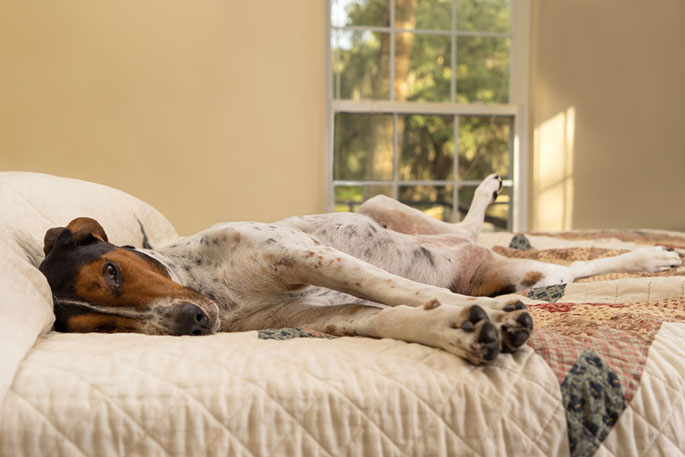
If your dog continues to sneeze and feels itchy all the time, the bedding needs to be blamed. So yes, dogs can be allergic to their beds. Usually, if you do not wash and replace the dog beds, it could be the primary reason behind dust mites. Dust mites are ubiquitous and microscopic. These mites feed on animal and human dander, hair, and skin scales. If the humidity and temperature are optimum, dust mites flourish in the house environment. These mites trigger allergy symptoms in your pet.
On recognizing that your dog could be allergic to something in the house, check the bedding that may harbor allergens. Also, you need to consider the right kind of bed that could provide some relief to your sensitive dog. Before going further, read about common symptoms and treatment for dust-mite allergies.
Symptoms of Dust Mite Allergies in Dogs
As dust mites are quite common round the year, allergies to them tend to be seasonal. Meanwhile, the dust mite allergies could be worse during the fall and spring. About 30 to 80 percent of cats and dogs test positive against dust mite allergies.
In dogs, some of the common symptoms of dust mite allergies could be itching around their feet and face, bacterial skin infections, ear infections or continuous inflammation, seborrhea, etc. So, these are some general signs that your dog can be allergic to dust mites, which are commonly found in their bedding.
Reasons why the dog’s bed triggers allergies
In case, your pet is allergic to its bed, the main culprit could be the filling. If you have not changed the bedding for a long time, it could definitely cause allergies in your dog. This is so because dust mites and fleas can increase over time in beds.
Generally, dog beds are packed with latex or synthetic foam.Choose a synthetic material for your dog’s bedding. Although these materials are resistant to molds and dust mites, they could still prove problematic. If moisture and skill cells accumulate on the foam surface, the accumulation facilitates the dust mite growth.It is advisable not to choose horsehairs, wool, feathers, or cedar shavings as stuffing. Thus, it is important to dust mite free dog beds for your canine friend.
Go with the right kind of dog bed
Dog mats and beds come in a wide range of external fabrics like faux fur, cotton, suede, polyester, wool, suede shearling, etc. As stated above, the primary source of dust allergens is the filling of your dog’s bed. However, some fabrics could even trigger allergies in your dog.
Synthetic fabrics need some processes and chemicals while manufacturing. The chemicals like flame retardants could be allergenic to animals. Also, some fabrics allow the build-up of dust mites, bacteria, mildew, and molds, which exacerbate skin allergies. So, experts recommend choosing allergy free dog beds made with 100% cotton, microfiber fabric, or hemp. These fabrics do not cause allergic reactions in dogs. Plus, hemp resists sun damage, tears, and mildew.
We recommend going with hypoallergenic dog beds as they are made up of thicker foam. If you choose a mattress having dense foam, it would not harbor allergens like dust mites. Also, cover the mattress with a tightly woven cover that will prevent dust mites from further penetration. Less-dense and loosely filled foam allows dust mites and dust to reside under the cover. Hypoallergenic dog beds are manufactured using a microfiber, which blocks the path of dust mites. Moreover, these beds are pretty easy to wash, which ultimately puts a stop to any bacterial skin infection in dogs. So, go with a dog bed that is not chemically-treated, simple to wash, and remain free of fleas, mold, dander, dust mites, and dust!
Diagnose and Treatment for Dust Mite Allergies
While diagnosing your pet, the vet will have a look at the history that shows whether that condition is non-seasonal in your pet or is not associated with skin parasites or food sensitivities. Also, your dog will be serum-tested to check their sensitivity to dust mites.
After the vet has confirmed the diagnosis against dust mite allergy, you should think of removing mites from your dog’s environment. It could be quite challenging as experts believe that the most effectual method for treating mites is airing out the clothes that your dog gets exposed to on a sunny day for around 12 hours. Once sun-dried, the fabrics need to be vacuumed. Some other suggestions for treatment include:
- Go with hypoallergenic dog beds for effective treatment
- Steam-clean pet bedding, mattresses, and upholstery furniture
- Vacuum all upholstery and carpets often with a HEPA-filtered vacuum
- Wash your dog’s bed in hot or cold water with tea tree oil at least in a month
- Cover the bed of your pet with sheets that repel dust mites
- Go with mattress covers manufactured with micro-porous fabric
Most veterinarians advise immunotherapy, which include tongue drops or allergy shots. This therapy is better than drugs like corticosteroids and cyclosporine as these immune-suppressant tablets shut your pet’s immune system. Before you opt for drugs, deal with the pet’s surroundings first. Go with options like foot soaks, feeding appropriately, regular baths, avoid over-medication, quality drinking water, and anti-inflammatory diet to make sure the immune system of your dog remains resilient and strong.
Now, you know that your dogs can be allergic to their beds. Here, we have stated some of the reasons why dogs are allergic to their beds. Choosing the right kind of bedding for your dog could prevent allergies arising from dust mites. Hence, it is advisable to select dust mite free dog beds or allergy-free dog beds for your lovely pet. Along with that, pet owners need to wash their dog’s bedding at least monthly for keeping it allergen-free.



